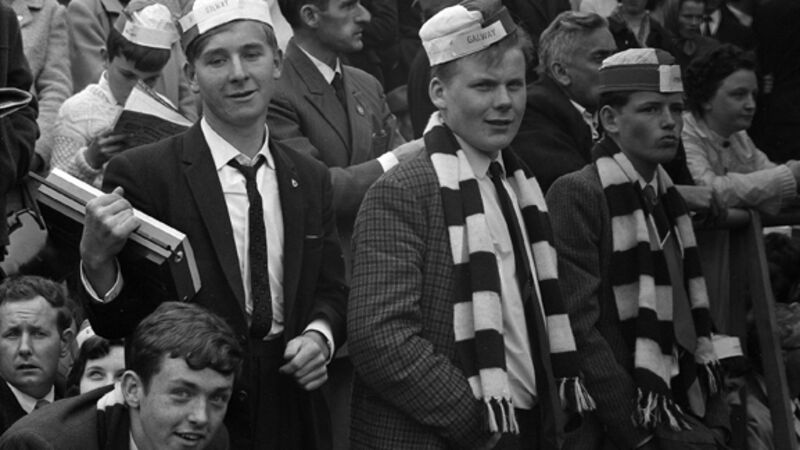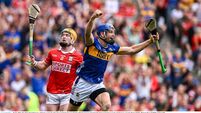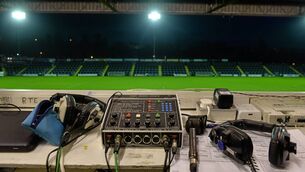Hurling as you have never seen it before

Then again, when is it ever not time for hurling?
Full disclosure: your columnist was involved in the making of the documentary series as an editorial consultant, so feel free to bear that in mind in evaluating my views.
On the other hand, have I ever left you down before?
Something to bear in mind when seeing the documentary is its origin story.
Colm O’Callaghan of RTÉ and John Murray of Crossing The Line Films were discussing high-end nature documentaries some years ago — the kind of programmes Crossing The Line specialises in — when they decided that a sports documentary utilising wildlife documentary techniques would be an interesting project.
The obvious example was the super-slow-motion film of a hummingbird, a sequence in which individual feathers flap and ripple as the bird beats its wings.
What particular sport would repay those techniques best? A sport in which, as one contributor to the documentary says, a couple of dozen lads chase a ball the size of a fist around a field.
You may have seen the trailer, in which a sequence from last year’s All-Ireland final figures: the sliotar rolls along the arm of a Galway defender, balanced impossibly, its progress tracked by the eyes of a Waterford attacker.
I used the word ‘impossibly’, which is wrong, of course.
In practically every game of hurling you can see the laws of physics stretched and defied, and this documentary isolates some pretty good examples of that at the very highest level.
Because you don’t often get the chance to thank people properly, bear with me when I say that many people who’d probably be described as dinosaurs by the likes of Damien Duff were hugely supportive of the project and facilitated its production at every turn.

They had the vision to see the necessity for a project like this one, which would do justice to the game of hurling, and to the views of some of its greatest exponents.
Almost 60 people were interviewed for the documentary series, often for up to three hours at a time.
If you feel that’s a little over the top considering the odd minute or two visible in the episodes, kudos to the GAA itself for its plan to make transcripts of those interviews available in the future, thus preserving the thoughts and opinions of some of the biggest names in hurling not on this game or that issue, but on the very attraction of hurling itself.
Reading Brian Cody’s thoughts about his club James Stephens, and its importance to him, or Donal O’Grady detailing what precisely it is that sets a top, top player apart, to take two examples, underscore the value involved.
The generosity of someone like Tommy Walsh with his club, Tullaroan, is one of the highlights of the series.
Director Gerry Nelson shows his class with some superb touches, not least the closing sequence in tonight’s first episode, but quality is a given on the production side here: Crossing The Line collected four Emmy nominations last week for projects such as The Farthest film and Wild Ireland.
Tune in this evening. It’ll keep you ticking over ’til next weekend’s replay at least.
The Game: The Story of Hurling, 9.35pm, RTÉ One.
Listening and learning
But in the course of a good bit of driving I’ve delved into a couple of interesting podcasts.
One is about books — Backlisted, in which assorted guests chat about relatively obscure books (backlisted.fm).
It’s a rambling, discursive chat, and all the better for that, even though it can take hosts John Mitchinson and Andy Miller 20 minutes of warming-up talk before they get to the meat of the matter.
I thought they were a bit generous to Last Exit To Brooklyn but some of the chunks of The Information that were read out made me want to revisit the book, which I suppose is the point.
Another one, which I couldn’t stop listening to, was Atlanta Monster, about the killings in Atlanta, Georgia, in the late 1970s and early ’80s (atlantamonster.com).
I have a vague memory of those killings being reported even here in Ireland, hot on the heels of pretty extensive coverage of the Son of Sam murders, and found the investigation, driven by host Payne Lindsey, which progressed through the episodes riveting.
As was the assertion that the man found guilty of two of the murders, Wayne Williams, may not have committed any of the crimes.
A TV milestone for women’s sport
The scene: Semple Stadium, July 4, 1999. Half-time in the Munster senior hurling final, a pretty tense affair between Cork and Clare.
Cork had just scored a goal with Seanie McGrath placing Joe Deane for a neat finish, and the stadium was buzzing with the possibility of an upset.
On the terraces at the Town End, there was a palpable sense of regime change on the horizon when a voice piped up from somewhere near the underside of the scoreboard: “Anyone got the score from the tennis?”
I was thinking of that brave soul when I saw during the week that this year, for the first time, the viewing figures for the women’s singles final at Wimbledon were greater than the men’s: 4.6 million versus 4.5 million.
Granted, as has been pointed out, there was the minor matter of a World Cup final the same day — though not precisely at the same time.
Granted, also, there was a far more attractive narrative surrounding the women’s final, with Serena Williams defying her high seeding to make the decider, than there was with the men’s.
But the latter point is an endorsement of the attraction of the women’s game.
And even if you don’t agree, the ‘victory’ in viewing figures was a revelation that passed without the kind of comment — or acknowledgement — one would expect.
Sorry Duffer, but GAA is no Jurassic Páirc
A week from the Cretaceous: before leaving Ballinskelligs after a recent holiday, I tripped down to the local GAA field, St Michael’s Foilmore, and saw kids from Coláiste Mhichil, the summer school, playing there.
While on the sideline I got a text about Gaelic Sunday, the upcoming centenary celebration of a crucial stand taken by GAA clubs to assert their right to play Gaelic games.
When I got home to Cork I had to take one of the smaller members of the family to an underage camogie blitz in Glen Rovers field — the number one field, I might add — which was brilliantly organised and hugely enjoyable for all concerned.
Late last week, I was alerted to a fundraiser supported, and attended, by many of the Clare senior hurlers in their own county.
The same Clare senior hurlers who gave the country an unforgettable 90 minutes’ entertainment on Saturday, and who’ll do the same again this Sunday.
They pitched in to help a fundraiser in Ruan in aid of one of their own, Zara Cronin, who needs neurosurgery, and €12,000 was raised in the process.
Similar events go on all over the country all the time, as any member of the GAA can tell you.
Some dinosaurs.








